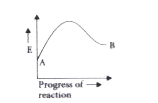Complete Solutions to MANDATORY EXERCISE (SET II) of chapter REACTION KINETICS AND CHEMICAL EQUILIBRIUM of Class 10 book with complete answers and questions
| Class 10 | CHEMISTRY |
| Chapter | REACTION KINETICS AND CHEMICAL EQUILIBRIUM |
| CENGAGE CHEMISTRY | MANDATORY EXERCISE (SET II) |
| Number Of Questions | 33 |
| Academic Year | 2023-24 |
How would you distinguish between
View SolutionFor the reaction `N_(2)O_(4)hArr2NO_(2)`, the concentrations of an equilibrium mixture at 293 K are: `[N_(2)O_(4)]=4.50xx10^(-2)` mol `L^(-1)` and `[NO_(2)]=1.61xx10^(-2)` mol `L^(-1)`. What is the value of equilibrium constant?
View SolutionThe equilibrium constant for the dissociation of HI `(2HIhArrH_(2)+I_(2))` is 25. What is the equilibrium constant for the formation of HI according to the reaction, `H_(2)+I_(2)hArr2HI?`
View SolutionThe rate constants of forward and backward reactions in a reversible reaction are `3.6xx10^(-4)` and `6.2xx10^(-6)`, respectively. Calculate the equilibrium constant of reaction.
View SolutionOne mol each of nitrogen and oxygen are heated in a 2 `dm^(3)` vessel. At equilibrium, one mol of nitric oxide is formed. Calculate the equilibrium constant for the reaction `N_(2)+O_(2)hArr2NO`.
View SolutionHow much `PCl_(3)` must be added to a one litre vessel at `250^(@)`C in order to obtain a concentration of 0.1 mol `dm^(-3)` of chlorine after re establishment of equilibrium? `K_(c)` for the reaction `PCl_(3)hArrPCl_(3)+Cl_(2)` is 0.044.
View SolutionHow is the dynamic nature of equilibrium explained?
View SolutionMention the conditions necessary to attain a state of equilibrium.
View Solution(a) State the law of chemical equilibrium.
(b) Write the expressions for equilibrium constants for the following pairs of reactions and establish the relation between them.
I. `H_(2)+I_(2)hArr2HI`
`HIhArr(1)/(2)H_(2)+(1)/(2)I_(2)`
II. `2NH_(3)hArrN_(2)+3H_(2)`
`(1)/(2)N_(2)+(3)/(2)H_(2)hArrNH_(3)`
View SolutionAt `448^(@)`C, the equilibrium constant for the reaction, `H_(2)+I_(2)hArr2HI` is 50.5. Predict the direction in which the reaction will proceed to reach equilibrium at `448^(@)`C, if we start with `2.0xx10^(2)` mol of HI, `1.0xx10^(2)` mol of `H_(2)` and `3.0xx10^(-2)` mol of `I_(2)` in a 2-L container.
View SolutionAn equilibrium mixture contains 6.4 g of sulphur dioxide, 9.6 g of oxygen and 24 g of sulphur trioxide in 1 L flask. Calculate the equilibrium constant for the reaction.
`2SO_(2)+O_(2)hArr2SO_(3)`
View SolutionThe rate constant of backward reaction is `2xx10^(-6)`. If the equilibrium constant is 4, calculate the rate constant of the forward reaction.
View Solution`AgNO_(3)+NaCl to AgCl+NaNO_(3)` is an irreversible reaction because
View SolutionThe unit of equilibrium constant for the reaction
`H_(2)+I_(2)hArr2HI` is
View SolutionThe equilibrium constant of a system is
View SolutionThe equilibrium constant of the reaction `A+BhArrC+D` is 10. If the rate constant of forward reaction is 203, the rate constant for backward reaction is
View Solution4 moles of A are mixed with 4 moles of B initially. At equilibrium, 2 moles of C are formed according to the reaction `A+BhArrC+D`. The equilibrium constant is
View SolutionIn the given graph the activation energy, `E_(a)` for the reverse reaction will be

Activation energy for the reverse reaction will be
View SolutionFor a reversible reaction `AhArrB` which one of the statements is wrong from the given energy profile

View SolutionA chemical reaction proceeds following formula rate `=p.z.e^(-E_(a)//RT)`. Which of the following process will increase the rate of reaction?
View SolutionConsider an endothermic reaction `AtoB` with the activation energies `E_(a) and E_(b)` for the forward and backward reactions respectively. In general
View SolutionWhich of the following is reversible process
I. Dissociation of HCl in water
II. Dissociation of Ethyl alcohol in water
III. Dissociation of `CaCO_(3)(s)` in open container
IV. Dissociation of `CaCO_(3)(s)` in close container
View SolutionWhich of the following represent chemical equilibrium?
View SolutionWhich of the following represent physical equilibrium?
View SolutionFor the homogenous reaction
`4NH_(3)+5O_(2)hArr4NO+6H_(2)O` the equilibrium constant Kc has the units
View SolutionA reaction chemical reaction is having two species in equilibrium. If the concentration of the both species are doubled then the equilibrium constant will
View SolutionWhich of the following is a wrong statement about equilibrium state?
View SolutionWhich of the following is not a physical equilibrium?
View SolutionFor an equilibrium reaction if the value of `K_(c)gtgt1`, then the reaction favoured more towards
View SolutionFor `PCl_(5)(g)hArrPCl_(3)(g)+Cl_(2)(g)`. Initial concentration of each reactant and product is 1 M. If `K_(ea)=0.41`, then
View SolutionThe reaction `2SO_(2)(g)+O_(2)(g)hArr2SO_(3)(g)+heat`. The equilibrium reaction proceeds in forward direction by
View SolutionWhen pressure is applied to the equilibrium system Ice `hArr` water. Which of the following phenomenon will happen?
View SolutionFor the gaseous reaction `C_(2)H_(4)(g)+H_(2)(g)hArrC_(2)H_(6)(g),DeltaH=-130kJ mol^(-1)` carried in a closed vessel, the equilibrium concentration of the `C_(2)H_(6)` can definitely be increased by
View Solution
MANDATORY EXERCISE (SET II) questions and complete solutions for chapter REACTION KINETICS AND CHEMICAL EQUILIBRIUM of CENGAGE CHEMISTRY of Class 10